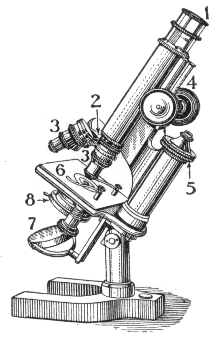AY Honors/Microscopic Life/Answer Key
From Pathfinder Wiki
< AY Honors | Microscopic LifeAY Honors/Microscopic Life/Answer Key /
Revision as of 03:29, 19 February 2007 by Jomegat (talk | contribs) (→3. Know how to calculate the magnification of a compound microscope. Calculate the magnification of the microscope you use for this honor.)
1. List four major types of microscopics. What are some of the characteristics of each? Be able to identify the different types of microscopes from pictures, or visit a laboratory in a university or industry which has these microscopes.
2. Be able to identify the following parts of a microscope and explain or demonstrate the function of each: eye-piece or ocular, objective, body tube, nosepiece, stage, diaphragm, base, focus knob, and arm.
- The eyepiece or ocular (1)
- The part of a microscope that a user looks into. It contains a lense called the ocular.
- Objective (3)
- The objective is another lens. It is located near the specimen to be observed.
- Body Tube
- This is a hollow tube that connects the ocular lens to the objective lens.
- Nosepiece (2)
- The nosepiece is a bend in the body tube that allows the microscope user to sit comfortably instead of hunched over the ocular looking straight down. It contains a prism that bends the light toward the viewer.
- Stage (6)
- The stage is a platform where the slides are mounted.
- Diaphram (8)
- The diaphram is an apparatus located beneath the stage. It focuses light onto the specimen.
- Base
- The base is the bottom of the microscope on which the rest of the instrument rests.
- Focus knob (4 and 5)
- The focus knob (or knobs) adjust the distance between the ocular lens and the objective lens. This brings the specimen into focus. Microscopes often come with two focus knobs - a coarse focus and a fine focus. The coarse focus knob makes large changes in the focus. The fine focus know makes smaller adjustments.
- Arm
- The arm connects to the base and other parts of the microscope (such as the stage, diaphram, and body tube) attach to it.
3. Know how to calculate the magnification of a compound microscope. Calculate the magnification of the microscope you use for this honor.
The magnification of a compound microscope is simply the magnifcation of the ocular lens times the magnification of the objective lens:
[math]\displaystyle{ magnification = ocular \times objective }[/math]
Therefore, if a microscope's objective lens has a magnification of 10 and its objective lens has a magnification of 40, the microscope's magnification is
[math]\displaystyle{ 10 \times 40 = 400X }[/math]
4. Define the following microscopic terms: slide, coverslip, wetmount, fixing, staining, oil immersion, unicellular, multicellular, cilia, flagella, plankton.
- slide
- coverslip
- wetmount
- fixing
- staining
- oil immersion
- unicellular
- multicellular
- cilia
- flagella
- plankton

